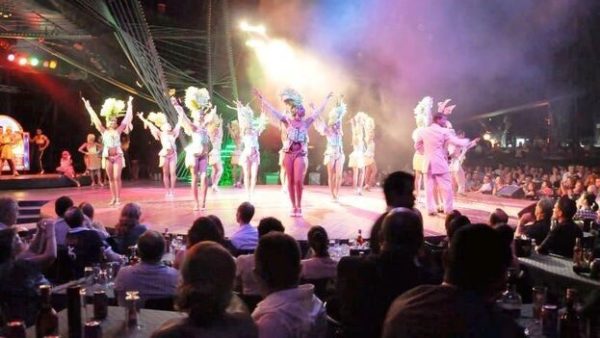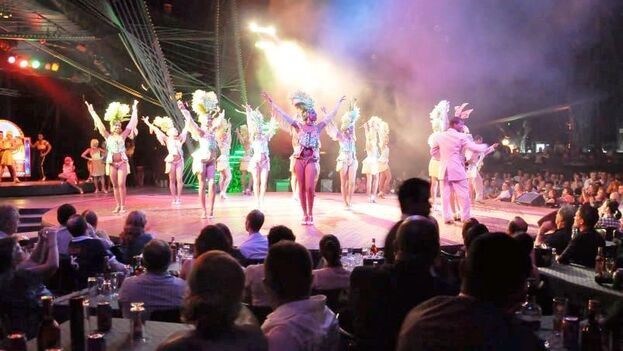
By Natalia Lopez Moya (14ymedio)
HAVANA TIMES – Twinkling lights, sculptural bodies and music. The propaganda about the Tropicana cabaret in Havana has barely changed in decades. The environment has changed and customers looking for a night of relaxation will have to overcome some obstacles, including the method of payment: a convoluted and frustrating mechanism that many see as a scam.
“They told us just to come and pay the entrance, but it is more complicated,” lamented a US citizen this Saturday, at the entrance of Havana’s most famous cabaret. The man, who traveled to the island with a group that had previously toured several Cuban evangelical communities, found that entry to the “paradise under the stars” could only be paid with magnetic cards, not cash. And the magnetic card had to be one bought in Cuba, loaded with ‘freely convertible currency’ [MLC].*
A ticket to just enjoy the Tropicana show regularly ranges between $75 and $95, depending on whether it is standard or Premium. If dinner is included, it can cost up to $120 and, this Sunday, December 31, as a special New Year’s Eve offer, with several services included, each person had to pay $300 dollars with the promise of also enjoying a special presentation of the dancers.
“USA cards do not work, so to enter they have to buy one in freely convertible currency [MLC]”, the employee at the Tropicana access checkpoint clarified to the group. With night already falling and temperatures cool for Havana, the last thing the anxious customers wanted was to delay their entry and postpone the first drink of rum to warm up their bodies.
Prepaid cards in Cuban ‘MLC’ are purchased at airports, hotels and the Island’s exchange offices known as ’Cadecas’. The cards can then be used to pay for hotel reservations, excursions, purchase of airline tickets, in stores, to rent a car, and to eat in restaurants. Their main function is to help travelers from the United States overcome the restrictions that the embargo imposes on financial operations between both countries.
However, after its implementation in mid-2021, what should have been a convenience has become a headache due to the continuous connection problems between the businesses that use them and the Central Bank. Distrust also accompanies this form of payment, which many tourists see as a nuisance, since it involves waiting in line to get them and, in addition, any balance that is not used on the Island is lost.
At the suggestion of a Tropicana employee, one of the foreigners went to a nearby hotel and bought an MLC card on which he deposited $800, an amount that covered the cost of entry for all the members of his group. But, his problems had just begun. “When we went to swipe the card, the device did not read it. We tried, but nothing,” the saddened tourist told 14ymedio.
Once, twice, three times and the device screen always gave an error message. “We have problems communicating with the bank,” insisted another employee, who assured that the payment terminal was “working perfectly for non-US Visa or Mastercard cards,” but “since the afternoon it has been having problems with the MLC cards,” an explanation that left the customers overwhelmed.
“We are losing money, because there are people who, when they find out that they have to return to the hotel and buy a card an MLC card, they do not return for the show,” a tourist guide who frequently takes groups of foreigners to visit the Tropicana acknowledges to this newspaper. “Everyone knows that it would be best if tourists could pay in dollars directly, but they don’t want to implement that for fear that the fulas [dollars] will end up in the workers’ pockets.”
“To prevent employees from pocketing part of the ticket money [which they do by giving a fake or recycled ticket to some tourists] they have created a mechanism that does not work and that only brings headaches to visitors,” he complains. Finally, after several attempts, the Americans paid with a Visa card from a bank in Spain that one of them, with business in that country, had on him.
“The problem is that these cards in MLC are not refundable, now they have to spend the money they deposited on it because they are not going to get it back even if the card has not worked due to problems for which they are not at all to blame,” emphasizes the official guide. “It can’t be done like that, we all lose from this.”
After obstacles at the entrance, the group of American tourists managed to access the Tropicana. But the night was no longer what they projected. Hanging over them was the question of how they were going to manage, in less than the 48 hours they had left in Cuba, to recover the 800 dollars deposited on the card. The guide, embarrassed, clarified that they could only withdraw Cuban pesos from ATMs – at the official rate of 120 CUP per dollar – or transfer the amount in MLC to the account of a relative or friend on the Island.
More than a cultural spectacle, the ‘paradise under the stars’ seemed, to the overwhelmed Americans that Saturday, a complete representation of the Cuban absurdity.
———
*Translator’s note: The irony is that the MLC cards must be bought with foreign credit cards, but the US credit cards cannot be used for anything else, and the MLC cards are worthless outside of Cuba.
Translated by Translating Cuba
Read more from Cuba here on Havana Times




